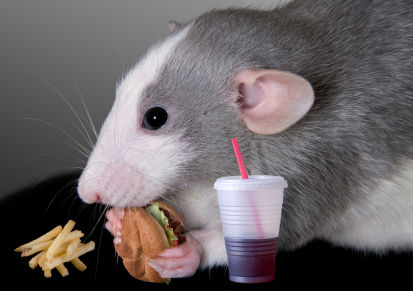New research by an expert on addiction has found the same pattern of behavior in rats on cocaine and rats self-dosing on high fructose corn syrup.
Dr. Francesco Leri, an associate professor of neuroscience and applied cognitive science at the University of Guelph in Ontario, Canada, presented these findings at the annual meeting last week of the Canadian Association for Neuroscience.
Leri has observed his "food addiction hypothesis" in two previously published studies, both using Oreo cookies, but this time he used actual high fructose corn syrup, selected "because of the controversy (over it) in the literature," he told me in an interview.
"We got the same results over and over, and now we are exploring the different aspects of it," he said.
Purchasing a "huge pail" of HFCS over the Internet, Leri diluted the syrup by mixing it with distilled water to three concentrations and by inserting a small tube in the test animal's mouth, the rats were able to press a lever and receive as many doses of HFCS as they wanted.
What Leri discovered was that the more he increased the percentage of HFCS, the more the rats worked to obtain it, which is "exactly what you notice with drug abuse, the same type of pattern," he said.
"The (rats') intake of the fructose is very much related to its concentration," said Leri. "When you change the percentage of the solution, the behavior changes, and the most compelling and most interesting evidence we have is that as you increase the percentage (of HFCS), the animals work harder and harder for each infusion."
Leri also "satiated" some of the rats by allowing them full access to their chow, and while the self-dosing of the HFCS decreased somewhat, "it was still there, it didn't go away," said Leri, adding that the rats "continued to prefer the higher concentrations."
The rats in Leri's study were also switched around from higher HFCS concentrations to lower, as well as the other way around, and their "behavior changed accordingly," he said. "So we're fairly confident that the self-administration behavior is controlled by the percent of the HFCS," he told me.
Sweetness itself not necessarily addictive
Leri also tested his rats to see if their addictive and sometimes binging behavior toward the HFCS was due to a possible 'species sweet tooth', so he substituted saccharine - mixed to be as sweet as the HFCS. While the animals showed the same initial "liking reaction," he noted, their self-administration of the saccharine subsequently fell significantly, unlike the way they responded to the HFCS.
"It's clear to us that the animals are not responding just because it's sweet," Leri contended.
"They are responding because HFCS has effects that are beyond the sweetness in the mouth ... effects on the brain."These "effects" could be "nutritional signals," he added, "but we think we're dealing with its effects on the reward system." Apparently, changing the saccharine concentration didn't increase the rats' desire to have more and more as it did with the HFCS. As he put it, "the curve is flat."
A study published this January in The Journal of the American Medical Association (JAMA), on people, not rats, showed some very similar findings - that when a person's brain is 'high' on excessive fructose it just doesn't know when to stop eating.
"When we gave participants a fructose drink...there was not that fullness signal getting up to the appetite control region," said study co-author Dr. Kathleen Page, assistant professor of clinical medicine at Keck School of Medicine of University of Southern California (USC).
The results of the USC study, conducted with 20 volunteers using MRI scans to view brain blood flow, Dr. Page said, were "exactly" what had previously been seen in lab experiments with animals.
While the FDA's 'legal limit' on the fructose content of HFCS is 55 percent (10 percent higher than sugar), some studies have shown fructose amounts in soft drinks containing HFCS to be as much as 20 percent higher than that. And in response to a petition filed with the Food and Drug Administration by Citizens for Health this past September, calling for the disclosure of actual amounts of fructose in HFCS, the Corn Refiners Association (CRA) itself has come out and admitted that an HFCS version with 90 percent fructose has been in use "with FDA knowledge for decades." (Read about the petition here, and sign it here).
Despite the scientific evidence that keeps piling up about HFCS, the CRA has its story and is sticking with it. The group's newly appointed president, John W. Bode, said in a prepared statement about Dr. Leri's study that "it is irresponsible and ultimately counter-productive for these researchers to associate safe and widely used foods such as high fructose corn syrup with illegal narcotics..."
But Dr. Leri is just as determined to continue his research, which will include a follow-up study of a side-by-side comparison of addictive drugs and HFCS.
"There is a subset of individuals that are particularly vulnerable, and this is what we are going to follow up with high fructose corn syrup," said Leri. "Not all of us develop compulsive, excessive, addictive patterns of consumption."
"The 50 percent (concentration) of HFCS controls behavior very powerfully, he explained. "If the concentration is very high, they almost have no choice, The effect of drugs are the same."




Reader Comments